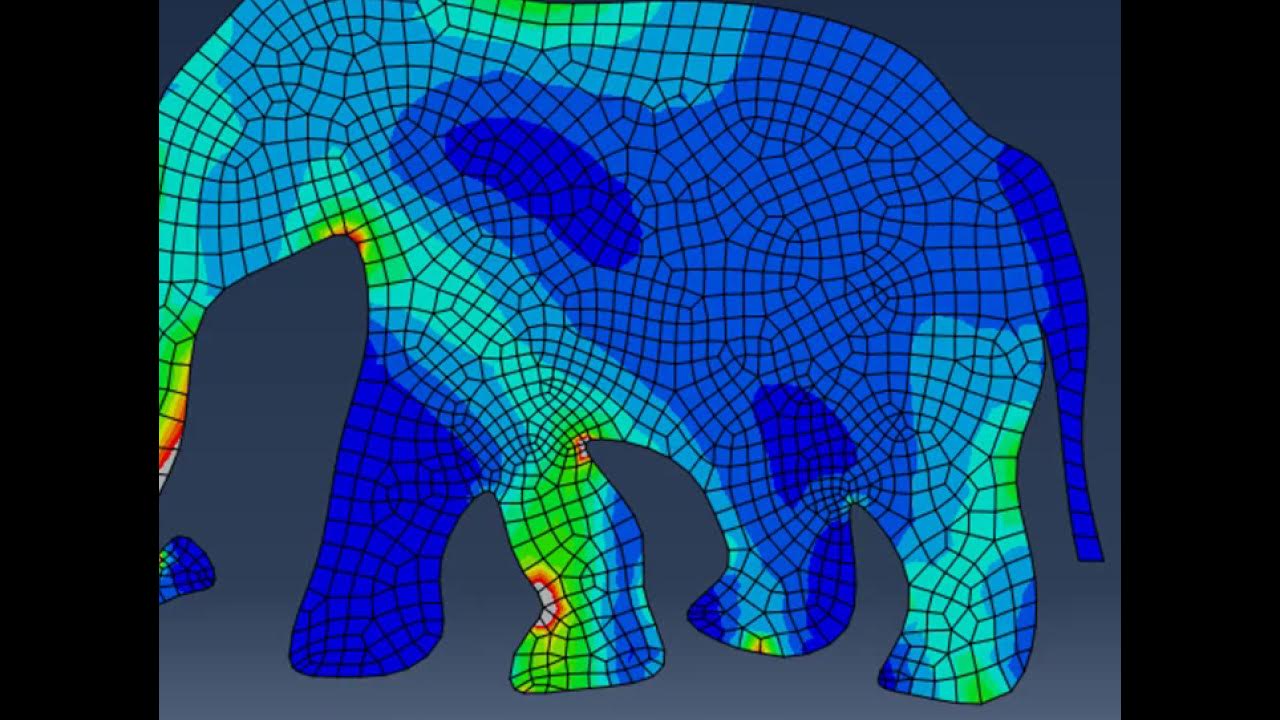FEA 26: Isoparametric Elements
Summary
TLDRThis video explains isoparametric elements, a type of finite element used in structural analysis, where transformations occur between local (natural) and global coordinate systems. Isoparametric elements employ the same shape functions for both displacement interpolation and coordinate mapping. The video covers the benefits of mapping four-sided and 3D elements from natural coordinates to global coordinates, and explores the process of creating stiffness matrices through this mapping. Additionally, it explains the importance of the Jacobian matrix in ensuring accurate integration and evaluating element quality.
Takeaways
- 🔄 Isoparametric elements use the same shape functions to interpolate displacement and map between local and global coordinate systems.
- 🌍 Elements can be defined either directly in the global system or transformed from a local system, with isoparametric elements opting for the latter.
- 🟥 Defining four-sided elements directly in global coordinates can be complex due to shape variations, whereas using local coordinates simplifies element definitions.
- 📐 The local coordinate system for isoparametric elements is called 'natural coordinates,' often using variables like 's' and 't'.
- 🔗 A key aspect of isoparametric elements is mapping from the natural coordinate system to the global coordinate system.
- 📊 The mapping between natural and global coordinates uses shape functions that are typically employed to interpolate displacements.
- 🧮 Calculating element stiffness matrices becomes easier using this mapping, reducing complex global integrations into simple operations in the natural coordinate system.
- 🔍 The Jacobian matrix plays a crucial role in the transformation, linking global and natural coordinates and helping with derivative calculations.
- 💡 The determinant of the Jacobian matrix represents the ratio of the element's area in global and natural coordinates, providing insight into element quality.
- ⚠️ A well-formed element has a nearly constant Jacobian, and a good rule of thumb is that the minimum determinant should be at least 70% of the maximum.
Q & A
What are isoparametric elements?
-Isoparametric elements are a type of finite element where the same shape functions are used to interpolate both displacements and map from a local coordinate system (natural coordinates) to a global coordinate system.
What is the advantage of using a local coordinate system in isoparametric elements?
-Using a local coordinate system simplifies element definitions because a single mathematical mapping can be applied to all elements, regardless of their shape or orientation in the global coordinate system. This makes the process of defining elements more consistent and easier.
Why is transformation necessary for four-sided elements in a mesh?
-Four-sided elements in a mesh can take on a variety of shapes and orientations. Defining each one directly in the global coordinate system would be complex and inefficient, so a local-to-global transformation simplifies this process and ensures consistency across the mesh.
What are natural coordinates in the context of isoparametric elements?
-Natural coordinates refer to a fixed coordinate system (often labeled s and t) used to define the element within a standard shape, such as a square. These coordinates are used in the local system for transformation to the global coordinate system.
How does mapping from natural coordinates to global coordinates work in isoparametric elements?
-Mapping is achieved by using the shape functions that define the displacement in the local coordinate system to relate the positions in the natural (local) coordinate system to the global coordinates. This ensures a consistent mapping for all elements.
What role do shape functions play in isoparametric elements?
-Shape functions in isoparametric elements are used for two purposes: they interpolate displacement within the element, and they are used to map the positions from the natural (local) coordinate system to the global coordinate system.
How is the stiffness matrix computed in isoparametric elements?
-The stiffness matrix is computed by integrating over the element, but rather than integrating in global coordinates (which would be complex), the integration is performed in the natural coordinate system (with limits from -1 to 1), making the process easier and more consistent.
What is the Jacobian matrix, and why is it important in the mapping process?
-The Jacobian matrix represents the derivatives of global coordinates with respect to natural coordinates. It captures the transformation information needed to map between the two coordinate systems. The inverse of the Jacobian is used to calculate derivatives needed for strain and stiffness matrix calculations.
Why is the determinant of the Jacobian matrix important?
-The determinant of the Jacobian matrix represents a scale factor that is the ratio of the element's area in the global coordinates to the area in the natural coordinates. This scale factor is critical for accurate integration and stiffness matrix calculation.
What does it mean if the determinant of the Jacobian matrix is not constant?
-If the determinant of the Jacobian matrix is not constant, it indicates that the element is not well-shaped or uniform. This could lead to an approximation error during numerical integration, affecting the accuracy of the stiffness matrix and the overall element quality.
Outlines

このセクションは有料ユーザー限定です。 アクセスするには、アップグレードをお願いします。
今すぐアップグレードMindmap

このセクションは有料ユーザー限定です。 アクセスするには、アップグレードをお願いします。
今すぐアップグレードKeywords

このセクションは有料ユーザー限定です。 アクセスするには、アップグレードをお願いします。
今すぐアップグレードHighlights

このセクションは有料ユーザー限定です。 アクセスするには、アップグレードをお願いします。
今すぐアップグレードTranscripts

このセクションは有料ユーザー限定です。 アクセスするには、アップグレードをお願いします。
今すぐアップグレード5.0 / 5 (0 votes)






